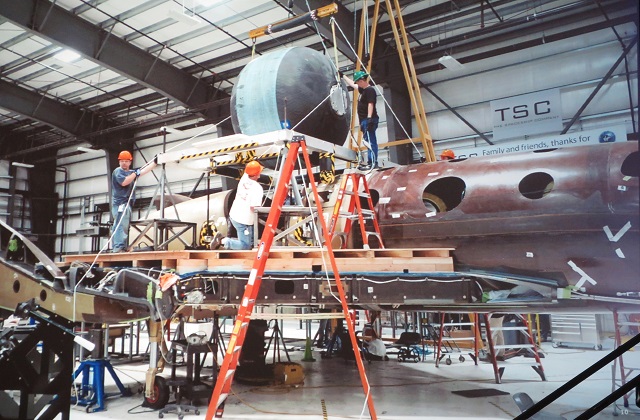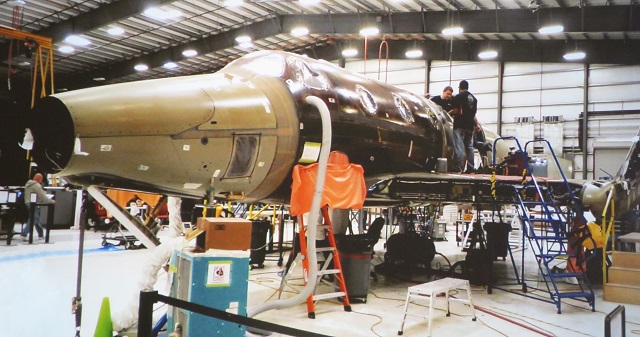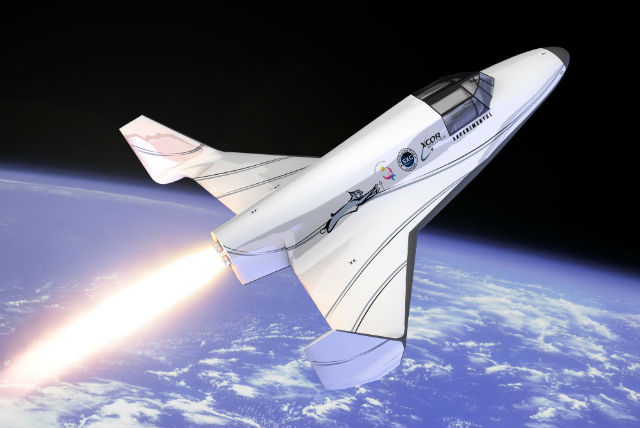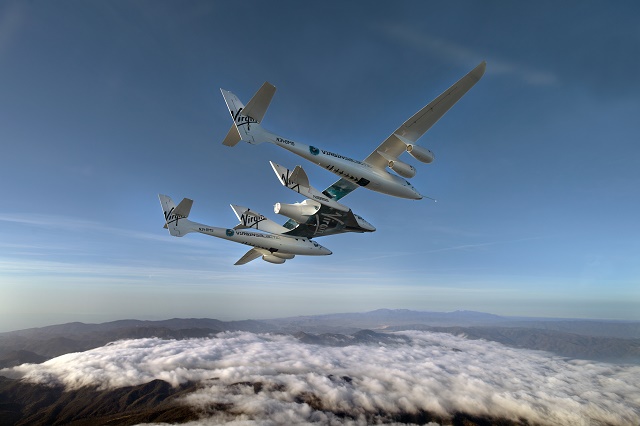One year ago this month, Virgin Galactic’s pursuit of suborbital space tourism turned to tragedy when its Scaled Composites-built SpaceShipTwo broke apart over the Mojave Desert just 13 seconds into its fourth powered flight.
The accident killed co-pilot Michael Alsbury, who had mistakenly unlocked an empennage feathering mechanism meant to reconfigure the vehicle for re-entry; in feathered mode the vehicle, returning from apogee at 100km-plus, should drop nose-first back into the high atmosphere and slow, stably, like a badminton shuttle but, not surprisingly, the result was catastrophic airframe failure during rocket-powered acceleration in thicker air. Pilot Peter Siebold escaped with his life by parachute, but was seriously injured.
SpaceShipTwo’s destruction grounded the programme pending a National Transportation Safety Board (NTSB) investigation and cast a long shadow over America’s fledgling personal spaceflight industry, which is pioneering new paths to space for ordinary travellers. But while many people thought the disaster might end Virgin Galactic’s drive to make suborbital journeys a matter of routine, Richard Branson’s space group is bouncing back – and even expanding.
As Virgin Galactic chief executive George Whitesides told the annual International Symposium for Personal and Commercial Spaceflight (ISPCS) in Las Cruces, New Mexico on 8 October, a second SpaceShipTwo (SS2-2) is in advanced stages of construction and will return the programme to flight testing “soon”. Its twin-fuselage launch aircraft, WhiteKnightTwo (WK2), is also preparing to resume operations.
The company, he adds, is wary of laying “unnecessary pressure” on the production team by detailing a timeline for return to flight testing, but progress to date suggests an early-2016 start.


SS2-2 under construction
Virgin Galactic
“We’re working three shifts now to finish the vehicle,” said Whitesides. “The trick with all these programmes is to find the right balance of moving quickly, but also building it right and building it safely.”
The project workforce has expanded by nearly a fifth compared to a year ago, he says. The space venture’s manufacturing arm, The Spaceship Company in Mojave, California, recently began installing the nitrous oxide tank that feeds the liquid-solid hybrid rocket motor – a second-generation RocketMotorTwo engine.
Whitesides says the oxidiser tank will be bonded to the fuselage “a little bit later in the year”; the solid fuel mix that was being tested for the first time when SS2 ripped apart is unchanged. At the conference he showed video of a full 60s test firing on a test stand in Mojave.

RocketMotorTwo test firing
Virgin Galactic
The air vehicle passed its weight-on-wheels milestone in May and the fuselage has been successfully mated with WK2. Critical fatigue testing and pressure cycle testing of the main cabin has also been done and improved pilot seats – and the avionics system – are being integrated into the cockpit. “We’re now working to integrate all the systems into the vehicle: the plumbing, the electrical, the pneumatics, and other systems,” Whitesides says.
SS2-2 reflects the findings of the NTSB, which held a public meeting outlining itspreliminary conclusionsin July, but has yet to issue its final report. According to the board, the probable cause of the crash was “Scaled Composites’ failure to consider and protect against the possibility that a single human error could result in a catastrophic hazard to the SpaceShipTwo vehicle”, and the Federal Aviation Administration also comes under fire for failing to recognise this shortcoming.
While the new vehicle features enhancements including a device to prevent the feathering unit from deploying prematurely, Virgin Galactic is perhaps understandably keen to show that little has changed – in terms of the space vehicle itself and the wider space tourism concept. Tickets remain on sale.
“At a top level, the airframe itself is sound, the propulsion system is sound, and we require very few changes to the vehicle following our test flight accident,” says Whitesides. He adds: “WhiteKnight should be flying very soon. That will be a great moment [when] she will be waiting for the spaceship, which should be coming along soon.”
When testing resumes, the company expects to move more quickly than in the first series, with two or three flights “rather than five or 10, to gradually inch up on a particular test point”. Nobody, however, should underestimate the scale of the challenge still facing Virgin Galactic. A programme which at one point expected to be making suborbital flights in 2010 has so far got no higher than 71,000ft, on its third powered flight in January 2014; at 328,000ft, suborbital space is still a long way away.
SAFETY, SAFETY
Meanwhile, other high-risk personal spaceflight ventures such as Blue Origin’s New Shepard and XCOR’s Lynx vehicles have yet to prove viability. Neither of those ventures has suffered a Virgin Galactic level catastrophe, but neither is progressing smoothly, either.
At Blue Origin – founded and bankrolled by Amazon billionaire Jeff Bezos – the New Shepard vertical-launch vehicle is expected to resume testing again this year. Its maiden launch in April was mostly successful; the capsule landed safely by parachute, but the main BE-3 propulsion stage, which should have returned to the pad for a controlled vertical landing, was lost owing to “loss of hydraulic pressure” during descent.


BE-3 lift-off and capsule recovery
Blue Origin
XCOR, meanwhile is developing a single-pilot, single-passenger runway take-off and landing rocket-plane. But like Virgin Galactic, it is years behind schedule – a first flight at one point touted for 2010 has yet to happen.
Hanging over all of them is an ongoing debate about whether the FAA should impose stricter safety regulations on the commercial space industry in the wake of the SS2 disaster. The prevailing view at the ISPCS gathering was that this is still very much an uncharted, experimental endeavour – and should not be held to the same uncompromising safety standards imposed on the air transport industry.
Wayne Hale of Special Aerospace Services, an engineering consultancy, tells Flightglobal that he hopes to see all three teams flying, but it is hard to tell if SS2, New Shepard and Lynx will all make it past the development phase.
“Virgin Galactic I would have said a year ago was in the lead. Of course, they had that awful and unfortunate accident and they’re going back and rebuilding their programme, which takes a while, and I can speak from experience,” says Hale – who ran NASA’s Space Shuttle programme from 2005 to 2008 and supervised the now-retired spacecraft’s return to space after the 2003 Columbia disaster.
“Blue Origin has got a really, really neat concept which they demonstrated 90% of, and I think they're really close to flying people into space. XCOR has a longer road ahead of them, from what I understand, basically because their financial situation is a little different. They don't have a billionaire backer, but they're making great progress.

Lynx
XCOR
“They are [all] competitive at some level, but like with this conference, everybody wants the larger enterprise of human beings going into space to succeed.”
ISPCS curator and director of the New Mexico Space Grant Consortium, Patricia Hynes, is one of more than 700 SpaceShipTwo ticket holders, and says most people recognise that testing almost always runs longer than planned and failures will happen and must be overcome.
She says despite the mishap, the SS2 was performing as designed. She was one of many ticketholders to encourage Branson to continue backing the space tourism venture when he reached out immediately after the disaster.
“It has a very good partner in Mojave air and space port,” says Hynes. “It has done over 50 different types of tests on the vehicle; so, it has done what the industry told it to do – be careful, be relentless, go step by step, don’t over-promise and under-deliver, do your job, do it well and let the job tell you when to launch.
“They’re changing the industry, they know it. They’re in the lead, they know that. They have to do it well for those coming behind them. They’ve been at it a long time. So they know they’re leaving a legacy even though they’re a young company.”
Whitesides, too, is pragmatic: “Space is not for the faint of heart. As a community, we push the boundaries.We’re looking forward to the future eagerly, because we think the opportunities are huge.”

SS2, WK2 in early captive test flight
Virgin Galactic
Source: FlightGlobal.com



















